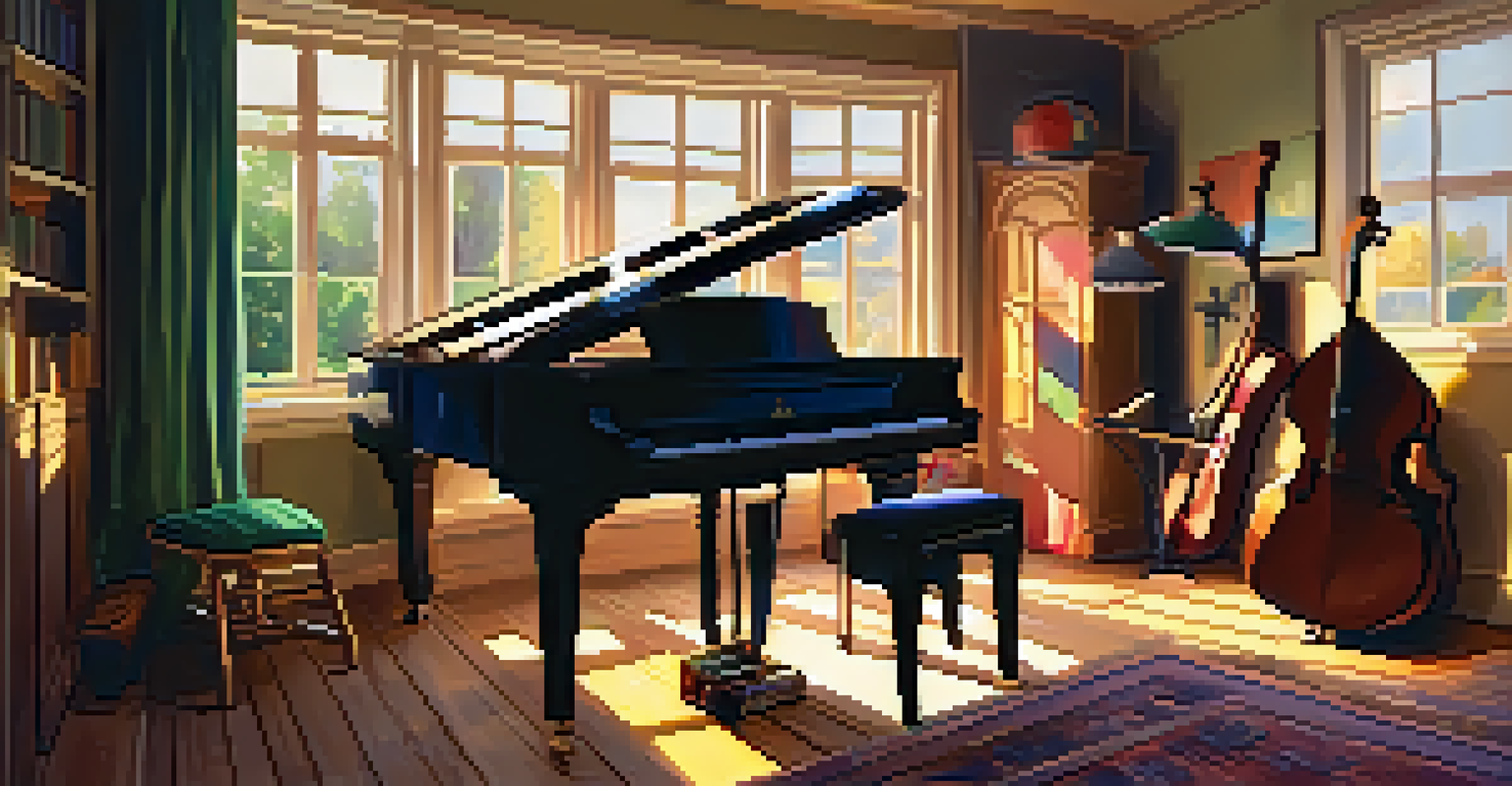Musical Texture: Layers of Sound in Composition Explained

What is Musical Texture in Music Composition?
Musical texture refers to the way different musical lines and parts combine to create a complete sound. Think of it as a tapestry, where each thread represents a different instrument or voice, woven together to produce a rich, full piece. Understanding texture helps composers create depth and complexity in their music, allowing listeners to experience sound in a vibrant way.
Music is the shorthand of emotion.
There are various types of musical texture, including monophonic, homophonic, polyphonic, and heterophonic. Monophonic texture features a single melodic line without accompaniment, while homophonic texture includes a main melody supported by harmony. Polyphonic texture, on the other hand, involves two or more independent melodies playing simultaneously, creating a more intricate soundscape.
Recognizing these textures can enhance your appreciation of music. For example, when you listen to a choir harmonizing, you can identify the homophonic texture at play, while a fugue showcases a polyphonic texture with its interweaving melodies. Each texture evokes different emotions and adds distinct layers to the overall composition.
The Importance of Layers in Musical Texture
Layers in musical texture are crucial because they contribute to the overall richness of a piece. Just like a delicious dish with multiple ingredients, a composition with various layers can evoke more profound emotional responses from its audience. By adding different instruments or vocal parts, composers can create a more immersive experience for listeners.

For instance, consider a symphony orchestra. The strings, brass, woodwinds, and percussion each add their own unique flavor to the music. When combined, these layers create a full, vibrant sound that can take you on an emotional journey, transporting you to different realms with each movement.
Musical Texture Enhances Sound
Musical texture refers to how different musical lines combine, creating a rich auditory experience similar to a tapestry.
In a more simplified context, think about a singer-songwriter with a guitar. When they add a harmonica or backing vocals, the texture of the song shifts, providing new dimensions that enhance the storytelling. These added layers not only enrich the sound but also help to convey the underlying message of the music.
Different Types of Musical Texture Explained
Musical texture can be categorized into several types, each with its own characteristics. Monophonic texture, being the simplest, consists of a single melody without any accompaniment. This type of texture is often found in folk songs or chant and highlights the beauty of a singular voice or instrument.
The beauty of music is that it connects people, transcending language and culture.
On the other hand, homophonic texture supports a main melody with chords or harmonies. This is commonly seen in most popular music, where a singer is accompanied by instruments that provide harmonic support, making it easy for listeners to engage with the melody.
Lastly, polyphonic texture features multiple independent melodies that interact with one another. This complexity can be found in Baroque music, such as Bach's fugues, where each voice or instrument has its own melody, creating a rich and dynamic listening experience. Understanding these types helps us appreciate the diverse ways composers express their creativity.
How Texture Affects Emotional Impact in Music
Musical texture plays a significant role in shaping the emotional impact of a piece. The layering of sounds can evoke feelings ranging from joy to melancholy, depending on how these textures are crafted. For example, a dense, polyphonic texture might create a feeling of overwhelming excitement, while a sparse, monophonic texture can evoke solitude or introspection.
Listeners often find themselves responding emotionally to the way textures evolve throughout a composition. A sudden shift from a rich, full sound to a lighter texture can create tension, leading to a release that feels cathartic. This ebb and flow of musical texture keeps the audience engaged, making the experience of listening to music more dynamic.
Layers Evoke Emotional Responses
The use of various layers in music can evoke profound emotional reactions, much like the complex ingredients in a delicious dish.
Furthermore, composers intentionally use texture to guide emotional responses. In a film score, for example, a gradual build-up of layers can signal impending action, heightening suspense. By understanding how texture influences emotions, both composers and listeners can navigate the depths of musical storytelling more effectively.
Analyzing Texture in Popular Music Genres
Popular music genres often utilize texture in unique ways to engage listeners. For instance, in rock music, the interplay between electric guitars, bass, and drums creates a powerful homophonic texture, driving the rhythm forward and making the music feel energetic. The layering of vocals, harmonies, and instrumental solos can further enhance this texture, adding depth to the overall sound.
In contrast, genres like classical or jazz often embrace more complex textures. Jazz, for example, features improvisation that can lead to intricate polyphonic textures, where musicians weave in and out of each other's melodies. This not only showcases each musician's talent but also creates a rich auditory experience.
Pop music, too, has evolved to incorporate various textures, blending elements from different genres. Artists often layer electronic beats with live instruments, resulting in a unique sound that captures listeners’ attention. By analyzing these textures within popular music, we can gain insights into the creative choices that shape contemporary sound.
Creating Texture: Techniques for Composers
Composers have a variety of techniques at their disposal to create texture in their works. One common approach is to vary the instrumentation, adding or subtracting layers to achieve the desired effect. For example, starting with a solo instrument and gradually adding more instruments can create a sense of build-up, drawing the listener in.
Another technique is to manipulate dynamics, such as varying the volume and intensity of different layers. A composer might start with soft, gentle textures and then build to a powerful climax, allowing the music to breathe and evolve. This dynamic contrast enhances the emotional journey of the piece.
Understanding Texture in Education
Learning about musical texture is essential for music education, helping students develop listening skills and a deeper appreciation for compositions.
Lastly, rhythm plays a crucial role in texture creation. By using different rhythmic patterns or syncopation, composers can differentiate layers and add complexity to the music. These techniques not only enrich the composition but also encourage listeners to explore the intricate layers of sound that make up the musical experience.
The Role of Texture in Music Education and Appreciation
Understanding musical texture is essential for both music education and appreciation. For students, learning about texture helps develop listening skills and a deeper comprehension of how music is constructed. By analyzing the textures in various pieces, students can gain insights into compositional techniques and the emotional effects of different layers.
For music enthusiasts, recognizing texture enhances the listening experience. Instead of passively enjoying a piece, listeners can actively engage with the music by identifying the different layers and how they interact. This deeper level of appreciation can lead to a more profound connection with the art form.

Additionally, educators can use texture as a tool to introduce music theory concepts. By discussing how different textures are created and their effects, students can better grasp the fundamentals of melody, harmony, and rhythm. This holistic approach to music education fosters a greater love and understanding of the art form.